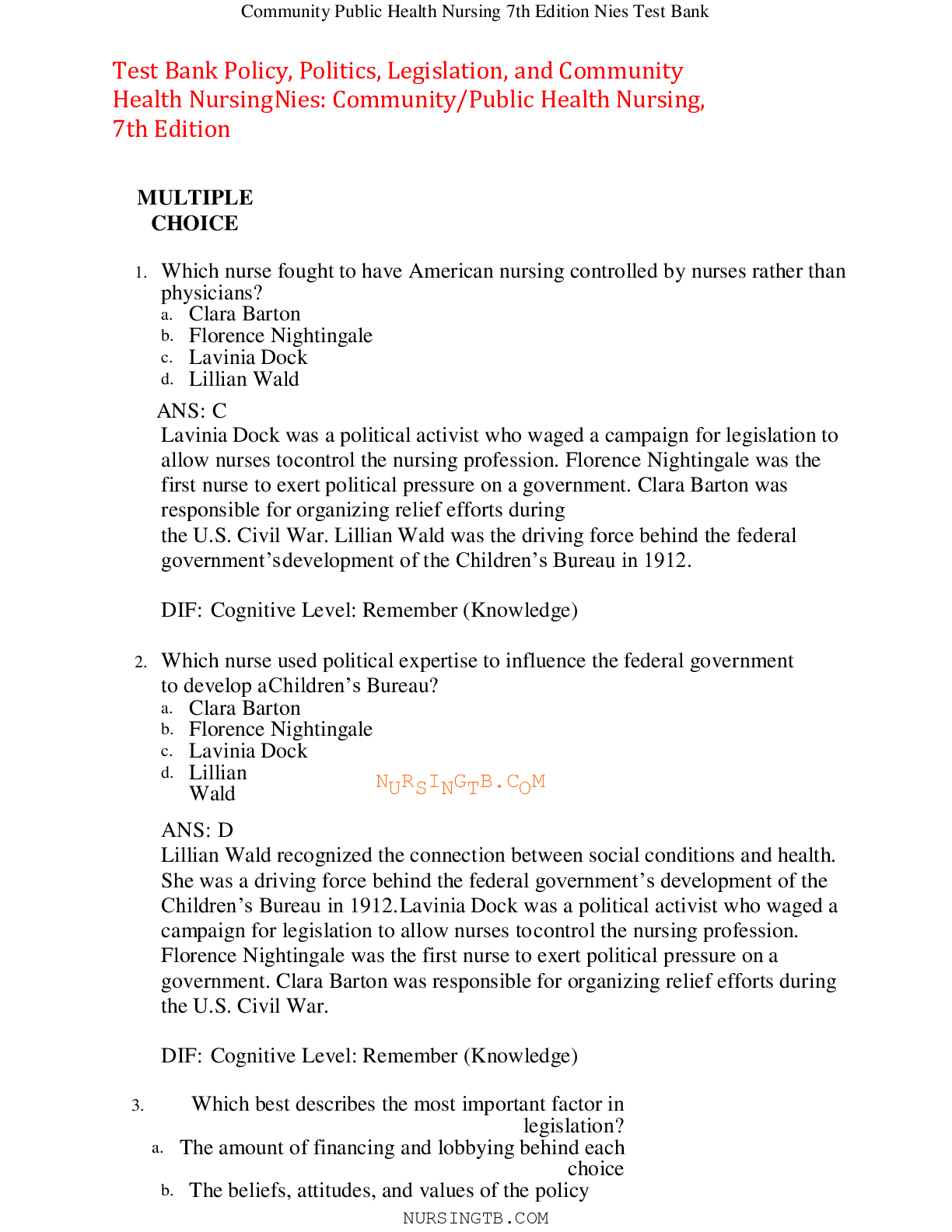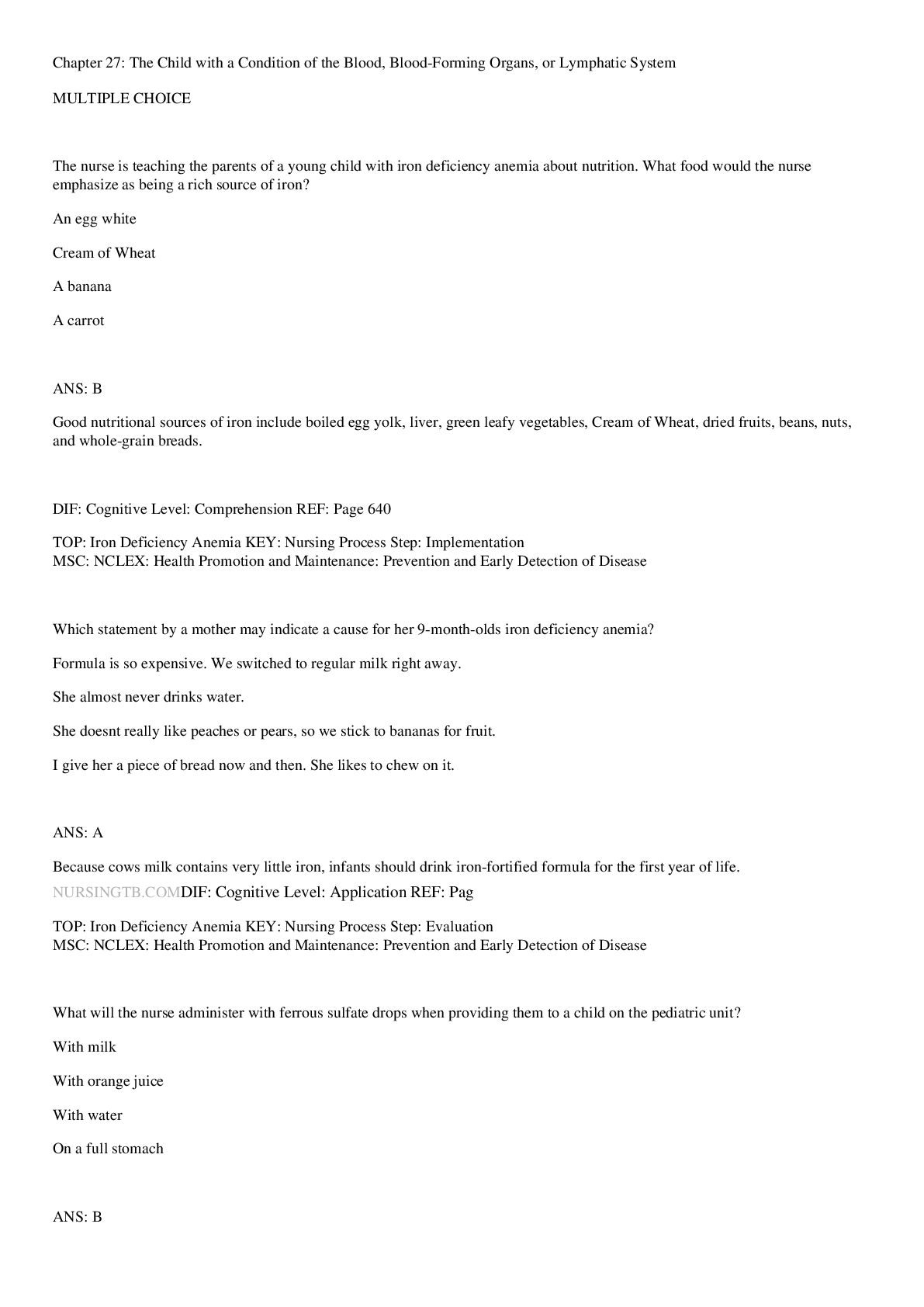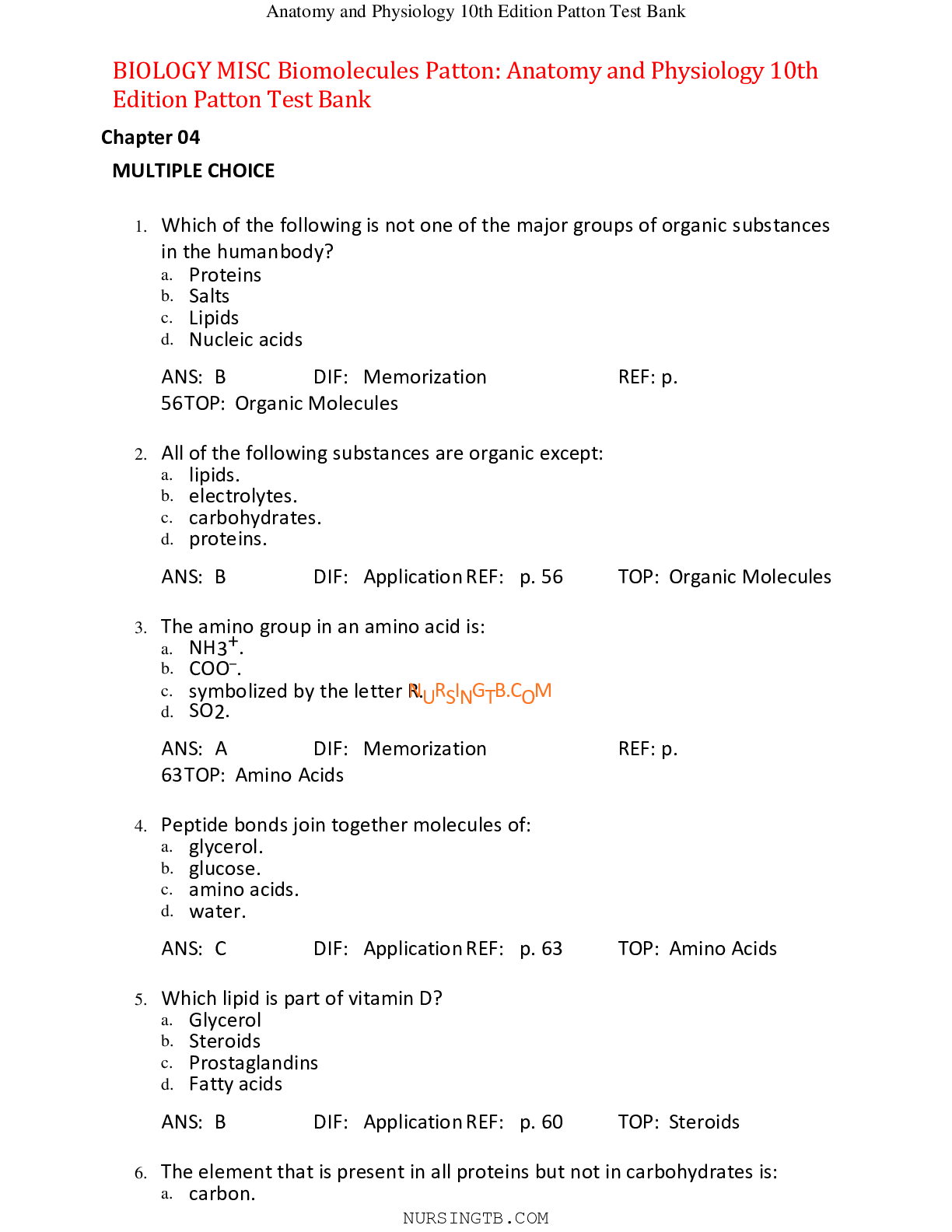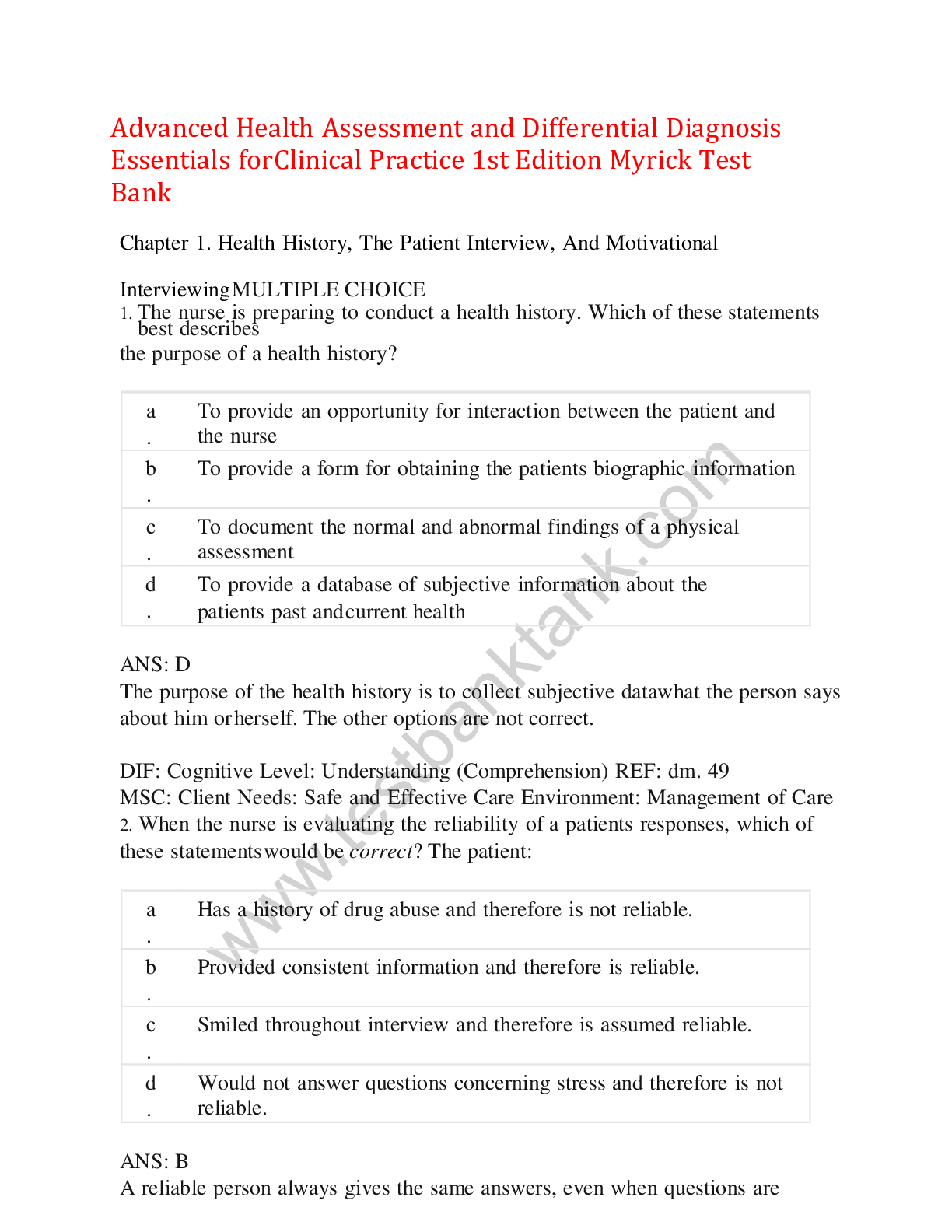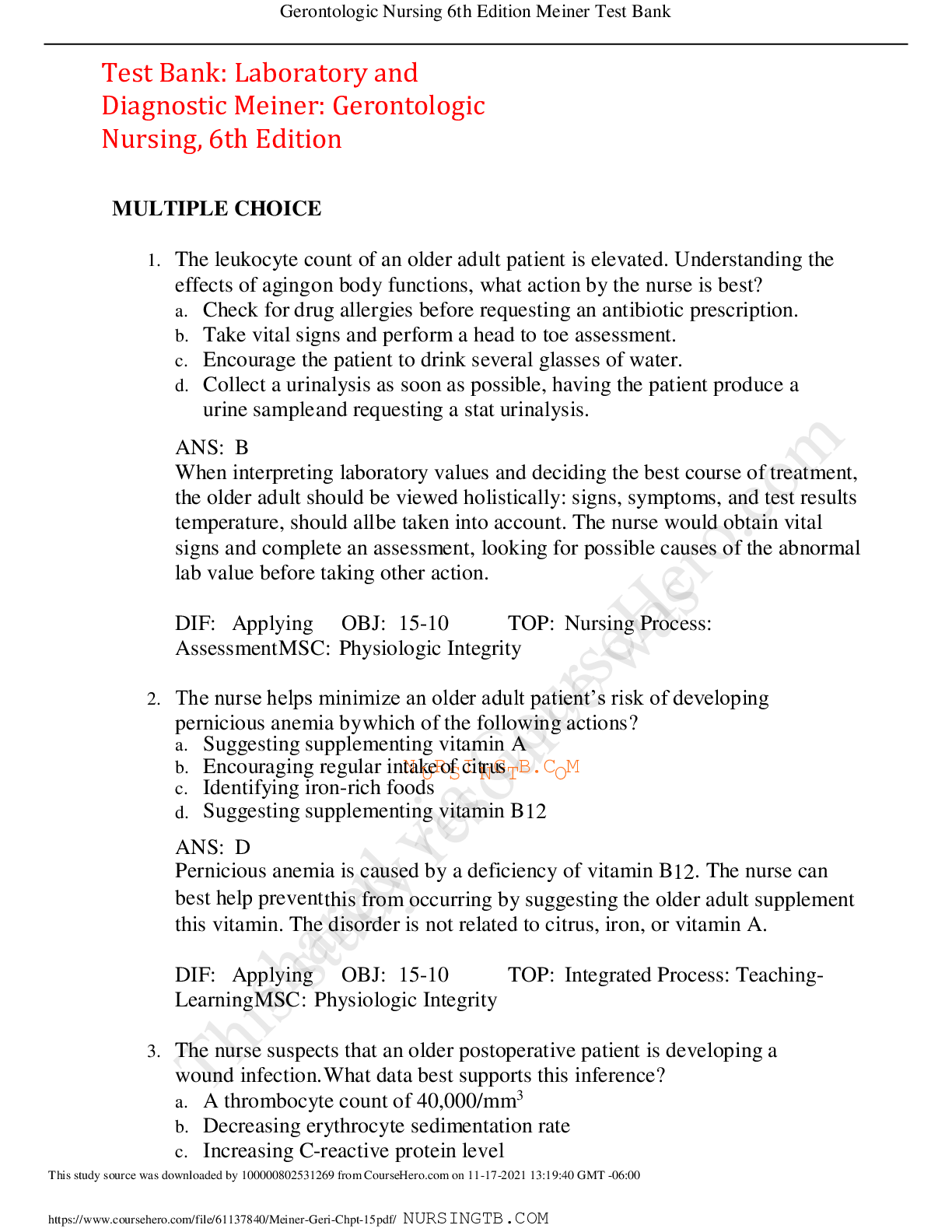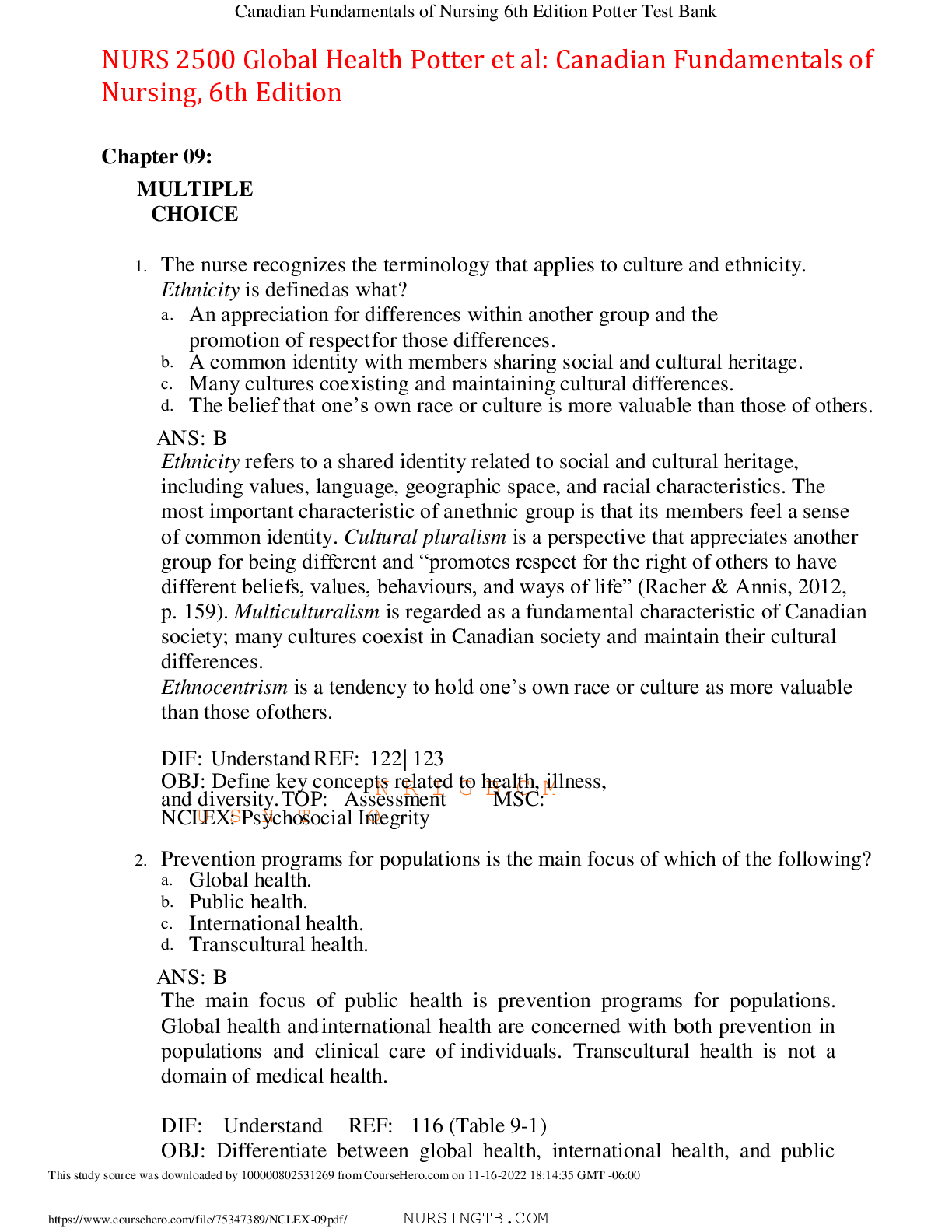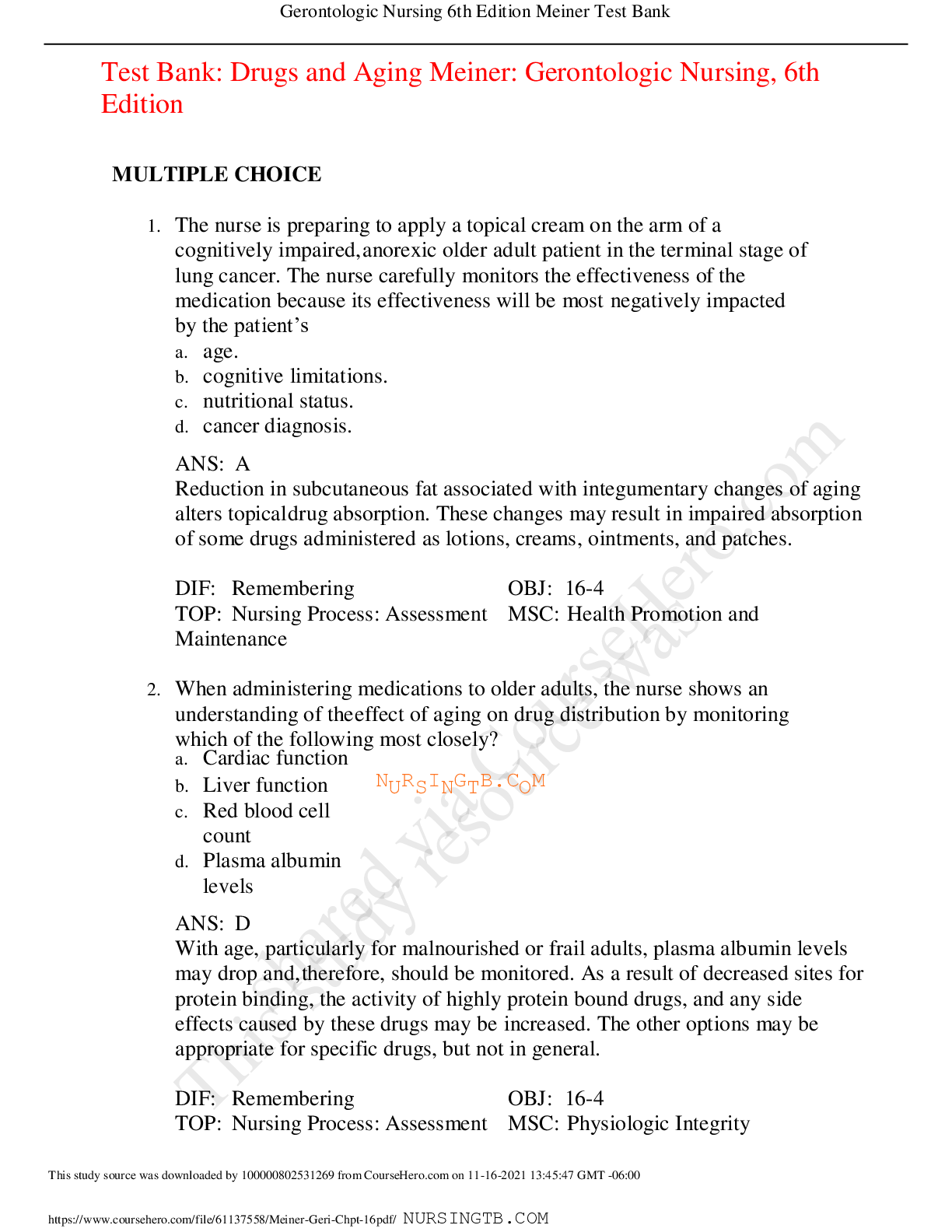*NURSING > TEST BANK > Test Bank: Nutrition Meiner: Gerontologic Nursing, 6th Edition,100% CORRECT (All)
Test Bank: Nutrition Meiner: Gerontologic Nursing, 6th Edition,100% CORRECT
Document Content and Description Below
Test Bank: Nutrition Meiner: Gerontologic Nursing, 6th Edition MULTIPLE CHOICE 1. The nurse caring for older adult patients best minimizes the patient’s risk of developing dehydration by a.... identifying the patient’s oral fluid preferences and offering them regularly. b. carefully monitoring the effects of daily diuretics via blood sodium levels. c. minimizing the patient’s reliance on laxatives by increasing dietary fiber intake. d. carefully monitoring of the rate of infusion of all intravenous fluids prescribed. ANS: A Physiologically, the decreased intake can be related to altered thirst; older adults may not feel thirsty even when hypovolemic. The other actions may be appropriate for selected patients. DIF: Applying OBJ: 9-1 TOP: Nursing Process: Implementation MSC: Physiologic Integrity 2. A patient is newly widowed and lives alone. Which suggestion by the nurse will help the adult children maximize the patient’s nutritional status? a. Help identify possible barriers to their mother achieving good nutritional health. b. Ensure that the patient has an adequate supply of healthy, easily prepared foods. c. Contact a food delivery service to provide one nutritiously sound meal a day. d. Arrange a schedule thatNaUllRowSsIsNomGeTonBe.toChOaMve dinner with her each evening. ANS: D The lack of companionship during mealtime that can lead to depression or social isolation often causes the patient to eat poorly and thus develop a nutritional deficiency. The patient who is newly widowed may not have adjusted to this change in status. The other actions are also helpful, but they are not as important for this patient. DIF: Applying OBJ: 9-1 TOP: Integrated Process: Communication and Documentation MSC: Psychosocial Integrity 3. The nurse conducting a food recall assessment on an older adult patient shows an understanding of the requirements of the process when doing which of the following? a. Having the patient identify any existing food allergies b. Asking the family to verify the patient’s statements c. Asking how the food being discussed was prepared d. Correlating diet information with signs of malnutrition ANS: C For accuracy and relevancy, the food recall must include specific information about the type of food ingested, the preparation method, and an accurate estimate of the amount. Allergies aren’t part of food recall (although they are important to know). The nurse does not need to have the family verify the patient’s statements unless the patient has cognitive dysfunction. Correlating diet information with physical signs is also not part of a diet recall. DIF: Applying OBJ: 9-3 TOP: Nursing Process: Assessment MSC: Physiologic Integrity 4. During a nutritional assessment, a 79-year-old patient responds, “My weight is fine. I weigh the same as I did 15 years ago.” The nurse responds based on the understanding that older patients a. generally guess their weight rather than weigh themselves. b. often rely on how their clothes fit to determine whether their weight has changed. c. sometimes experience altered metabolic problems that hide weight change. d. often exchange lean muscle mass for body fat so weight stays the same. ANS: D With age there is a loss of lean body mass and an increase of body fat; therefore, body weight alone can be misleading. DIF: Remembering OBJ: 9-4 TOP: Nursing Process: Assessment MSC: Physiologic Integrity 5. An older adult patient has experienced severe nausea and vomiting for 2 days since undergoing abdominal surgery. What explanation to the family best explains this test? a. “The provider is interesNtedRin wIhetGherBth.erCe isMenough available protein in the blood.” b. “This test is designed to determine how the body is meeting current demands for protein.” c. “The test will tell us if the vomiting has created a problem with protein metabolism.” d. “Healing from such a surgery requires protein, and this test measures protein.” ANS: B This test is sensitive to sudden demands on protein synthesis and is often used in the acute care setting. Healing from surgery does require sufficient protein stores, and this test can help the nurse, dietician, and provider determine if the patient needs extra nutritional support. DIF: Understanding OBJ: 9-4 TOP: Integrated Process: Teaching-Learning MSC: Physiologic Integrity 6. The nurse notes a patient’s prealbumin is 2 mg/dL. What action by the nurse is best? a. Tell the patient to add more protein to the diet. b. Conduct a nutritional screening with a standard tool. c. Refer the patient to a registered dietician. d. Instruct the patient to maintain good nutritional habits. ANS: C Normal albumin levels are above 15 mg/dL. Values below 5 mg/dL are considered a marker for severe protein deficiency. The nurse should enlist the services of a registered dietician to help manage this patient. Adding more protein to the diet and conducting a nutritional screening are not the best answers because the nurse already knows the patient is severely malnourished. Instructing the patient to maintain his or her good nutritional habits is not the correct because the patient is malnourished, so some changes have to be made. DIF: Analyzing OBJ: 9-5 TOP: Integrated Process: Communication and Documentation MSC: Physiologic Integrity 7. A nurse works with a patient who is malnourished. What lab value does the nurse assess for the most up-to-date information on the patient’s status? a. Albumin b. Prealbumin c. Transferrin d. Total iron ANS: B Prealbumin has a half-life of 2 to 3 days, so it is the most accurate measure of the patient’s current status. Albumin’s half-life is 21 days; transferrin’s half-life is 8 to 10 days. Total iron does not indicate current nutritional status as accurately as the others. DIF: Remembering OBJ: 9-3 TOP: Nursing Process: Assessment MSC: Physiologic Integrity N R I G B.C M 8. The nurse has conducted a nutrition screen on a patient using the Nutrition Screening Initiative tool. The patient scored a 4. What action by the nurse is most appropriate? a. Refer the patient to a dietician for a nutritional assessment. b. Encourage the patient to add more protein items to the diet. c. Reinforce the patient’s good eating habits and nutrition. d. Consult the provider about adding an iron supplement. ANS: A A score of 3 or higher indicates moderate nutritional risk. The nurse consults a dietician for a more in-depth nutritional assessment. Adding more protein items to the diet is probably a good idea, but this is not the most comprehensive answer. The nurse can reinforce the good eating habits the patient does have, but the patient needs more intervention. The patient may or may not need an iron supplement. DIF: Analyzing OBJ: 9-3 TOP: Integrated Process: Communication and Documentation MSC: Safe and Effective Care Environment 9. A nurse is caring for a vegetarian patient who has a protein deficiency. What menu items does the nurse select for the patient? a. Lean beef b. Chicken c. Beans d. Pork ANS: C Vegetarians do not eat any meat, so to get a food high in protein, the nurse selects beans. DIF: Remembering OBJ: 9-5 TOP: Nursing Process: Implementation MSC: Psychosocial Integrity 10. A nurse is caring for four patients. On which patient should the nurse plan to conduct a further nutritional assessment? a. The patient who has lost 10% of body weight in 1 month b. The patient who has lost 5 pounds with exercise in 1 month c. The patient who gained 3 pounds while on vacation d. The patient who weighs 12% over ideal body weight ANS: A Loss or gain of 5% of body weight in 1 month puts a patient at nutritional risk. The other patients are not at nutritional risk. DIF: Analyzing OBJ: 9-3 TOP: Nursing Process: Assessment MSC: Physiologic Integrity 11. An older patient asks why he needs a multivitamin supplement. The patient has always been healthy, has excellent nutrition, and has never needed vitamins. What explanation by the nurse is best? a. Older people tend to eat fewer calories, so it’s harder to get nutrients. b. You need to have extra nutritional reserves in case of sudden illness. c. It’s recommended in all tUhe nSutriNtionTal guideOlines for older adults. d. Now that you are older, your good nutritional habits are not enough. ANS: A Older people do tend to eat fewer calories, making it more difficult to get all the needed nutrients. Stating that old habits are no longer good enough is not quite accurate. Extra nutritional reserves are a good idea, but the patient may not feel vulnerable to illness. Stating that it is in the nutritional recommendations does not give the patient useful information. DIF: Understanding OBJ: 9-1 TOP: Integrated Process: Teaching-Learning MSC: Health Promotion and Maintenance 12. A community nurse assesses participants at a senior center for risk of malnutrition. What senior does the nurse consider most at risk for malnutrition? a. Impoverished b. Lives alone c. Has dentures d. Has arthritis ANS: A There are several social determinants that contribute to malnutrition, but poverty has the most impact. Living alone or having dentures or arthritis could affect nutrition, but they are not as likely as poverty to lead to a nutritional deficit. DIF: Remembering OBJ: 9-1 TOP: Nursing Process: Assessment MSC: Physiologic Integrity 13. The nurse is supervising unlicensed assistive personnel (UAPs) while they feed different residents at a nursing home. The nurse offers which suggestion to the UAP feeding a resident with apraxia of swallowing? a. Cut the food into smaller pieces. b. Remind the resident to swallow. c. Offer fluids between bites. d. Sit the resident up straighter. ANS: B Apraxia is the inability to perform certain purposeful movements due to neurological problems, such as dementia. The patient with apraxia of swallowing would need to be reminded to swallow. The other options are all good choices for individual residents to prevent aspiration. DIF: Applying OBJ: 9-1 TOP: Integrated Process: Teaching-Learning MSC: Safe and Effective Care Environment 14. A nurse visits an older adult living with family. The adult’s lab results show a vitamin D deficiency. The adult refuses to take any more medications. What action by the nurse is best? NURSINGTB.COM a. Offer to call the provider for a different supplement. b. Document the person’s refusal to take the supplement. c. Encourage the person to get direct sunlight each day. d. Inform the person that B vitamins aren’t absorbed without D. ANS: C Two-thirds of a person’s vitamin D is synthesized in the skin via sunlight. If the person refuses to take a supplement, this option is best. A different supplement won’t work as the older adult has said “no” to more medications. The nurse will document the person’s response, but there is more the nurse can do. Calcium metabolism is affected by vitamin D. DIF: Applying OBJ: 9-6 TOP: Integrated Process: Teaching-Learning MSC: Health Promotion and Maintenance 15. The nurse has admitted a patient with sarcopenia to the hospital for pneumonia. What action by the nurse takes priority? a. Follow universal precautions while doing care. b. Place the patient on fall risk status. c. Encourage a high protein diet. d. Request a physical therapy consultation. ANS: B Sarcopenia is a decline in muscle mass, which would lead to weakness. The nurse would place the patient on fall risk precautions as the priority. Protein and physical therapy can help the patient but are not priorities. The nurse uses universal precautions with everyone. DIF: Applying OBJ: 9-1 TOP: Nursing Process: Implementation MSC: Safe and Effective Care Environment 16. A patient has xerostomia. What intervention should the nurse add to the patient’s care plan? a. Sit the patient upright when eating. b. Offer creamed soups and pudding. c. Have the patient double swallow. d. Give fluids after each bite of food. ANS: D Xerostomia is dry mouth, which causes patients to have difficulty forming a food bolus, chewing, and swallowing. Offering fluids between each bite of food may help the patient eat. The other options are not related to xerostomia. DIF: Applying OBJ: 9-1 TOP: Nursing Process: Implementation MSC: Physiologic Integrity 17. A patient has dysphasia. What assessment by the nurse would indicate that the priority goal for this problem has been met? a. Patient eats 75% of all meals. b. Patient uses adaptive swallowing techniques. c. Patient’s lungs are clear. d. Patient remains sitting uNpUaRftSerImNeGalsT. B.COM ANS: C The priority goal for a patient with dysphagia is to not aspirate. Clear lungs sounds demonstrate that. Adaptive swallowing and sitting upright can help prevent aspiration but do not indicate if the patient has or has not aspirated. Eating 75% of meals is not related. DIF: Analyzing OBJ: 9-5 TOP: Nursing Process: Assessment MSC: Physiologic Integrity MULTIPLE RESPONSE 1. The nurse is caring for several patients on an inpatient unit who are either malnourished or at nutritional risk. Which patient would the nurse determine is a candidate for parenteral nutrition? (Select all that apply.) a. Recent neck dissection for throat cancer b. Admitted with severe inflammatory bowel disease c. Prealbumin level of 7 mg/dL d. Lost 10 pounds after GI virus e. Severe pancreatitis exacerbation ANS: B, E Patients who are candidates for parenteral nutrition have gastrointestinal tracts that either cannot be used or cannot absorb nutrients. The patients with inflammatory bowel disease and pancreatitis need bowel rest, so they are candidates for parenteral nutrition. The patient with throat cancer can use enteral nutrition. The prealbumin level is in the normal range. The patient with a recent GI virus is most likely severely dehydrated, which must be addressed first. DIF: Analyzing OBJ: 9-5 TOP: Nursing Process: Assessment MSC: Physiologic Integrity 2. The nurse assesses patients for drug–nutrient interactions. What medication/nutrition combination is problematic? (Select all that apply.) a. Digitalis and nausea b. Steroids and weight gain c. Furosemide and potassium retention d. Mineral oil and fat-soluble vitamin deficiency e. Acetaminophen and diarrhea ANS: A, B, D Digitalis preparations can lead to nausea, especially if the patient’s blood level is over the therapeutic level. Steroids often cause weight gain. Mineral oil affects the absorption of fat-soluble vitamins. Furosemide is a potassium-wasting diuretic. Acetaminophen is not usually associated with diarrhea. DIF: Remembering OBJ: 9-1 TOP: Nursing Process: Assessment MSC: Physiologic Integrity NURSINGTB.COM [Show More]
Last updated: 10 months ago
Preview 1 out of 13 pages

Reviews( 0 )
Document information
Connected school, study & course
About the document
Uploaded On
Nov 21, 2021
Number of pages
13
Written in
Additional information
This document has been written for:
Uploaded
Nov 21, 2021
Downloads
0
Views
50

